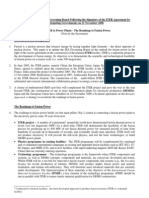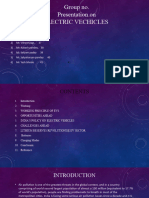NPCIL
NPCIL
Uploaded by
NikunjCopyright:
Available Formats
NPCIL
NPCIL
Uploaded by
NikunjOriginal Description:
Copyright
Available Formats
Share this document
Did you find this document useful?
Is this content inappropriate?
Copyright:
Available Formats
NPCIL
NPCIL
Uploaded by
NikunjCopyright:
Available Formats
NUCLEAR POWER CORPORATION OF INDIA LTD.
The Nuclear Power Corporation of India Limited (NPCIL) is a government-owned
corporation of India based in Mumbai.
NPCIL is administered by the Department of Atomic Energy (DAE), part of the Ministry
of Science and Technology.
NPCIL was created in September 1987 as public limited company under the
Companies Act 1956, "with the objective of undertaking the design, construction,
operation and maintenance of the atomic power stations for generation of electricity in
pursuance of the schemes and programmes of the Government of India under the
provision of the Atomic Energy Act 1962." All nuclear power plants operated by the
company are certified for ISO-14001 (Environment Management System).
NPCIL is responsible for design, construction, commissioning and operation of nuclear
power reactors. Atomic Energy Act, 1962. NPCIL has also equity participation in
BHAVINI, an organization formed for implementation for Fast Breeder Reactors
programme in the country.
ENERGY REQUIRMENT
Electrical energy is the basic need for
development of every Country.
Unavailability of energy leads to: a. Poverty b.
Poor Health c. Reduced educational attainment
Key Issues of NPCIL
A) India faces many acute challenges of energy development, which has caused the countrys
leaders to consider Indias indigenous energy sources and how it can increase energy supply to
better meet the exponentially expanding energy demand.
B) Given this demand, India has chosen to pursue nuclear energy as a source of energy, and
is planning a rapid expansion of the nuclear power sector in the coming decades.
C) Green scenarios (solar, nuclear, or a combination) should be considered.
D) Development deficits and lack of sufficient energy are also issues that can create their own
security problems over time.
E) India has chosen to develop a closed fuel cycle because of its limited domestic sources of
uranium.
Stakeholders
Government
Farmers
Environmentalists
Atomic Energy Regulatory Board
Regulatory issues
In the United States, the complaint of the
nuclear industry is that the process for the
approval of new reactor designs is laborious,
expensive, and sometimes done with criteria
that reflects older knowledge than the latest
developments in the industry.
In India, the hurdles start sooner in that the
Atomic Energy Regulatory Board (AERB) is not
a body independent of the chain of command of
those it regulates.
Legal issues
There is a small legal problem (for the tie-up
between NTPC and Nuclear Power Corporation
of India). Under the Atomic Energy Act,
activities in the nuclear field are exclusively
limited to the Government of India and PSUs
owned by the GOI.
Recommendation
The first stage of commercially successful nuclear power programme
has indicated that country has command on the technology through
its own R&D base built since the beginning of establishing
Department of Atomic Energy. On this strength it could withstand the
technology denial regime for years. The second stage (Fast Breeder
Reactor) programme has been initiated. Given the scientific and
technological capability demonstrated so far, the technology required
for optimizing the second stage programme and launching the third
stage programme can be developed to assure long term energy
security at the desired capacity.
References
https://www.nap.edu/read/18412/chapter/9#127
https://en.wikipedia.org/wiki/Nuclear_power_in_India
http://www.business-standard.com/article/companies/ntpc-npcil-jointventure-facing-issues-114061000945_1.html
http://www.firstpost.com/india/the-problems-with-indias-atomic-energyexpansion-a-critique-by-a-nuclear-energy-evangelist-2566490.html
https://www.nap.edu/read/18412/chapter/9
http://link.springer.com/article/10.1007/s12046-013-0187-4
http://www.world-nuclear.org/information-library/countryprofiles/countries-g-n/india.aspx
http://www.npcil.nic.in/pdf/CMD_paper_07dec2010.pdf
You might also like
- NPCIL/RAPP Vocational Traniee ReportDocument37 pagesNPCIL/RAPP Vocational Traniee Reportanil chejaraNo ratings yet
- Marketing Analysis of KFCDocument3 pagesMarketing Analysis of KFCÁnh NgọcNo ratings yet
- The Purple Prince of Oz - L. Frank BaumDocument198 pagesThe Purple Prince of Oz - L. Frank BaumbobbyejayneNo ratings yet
- Energy and Environment: Symbiosis Institute of Management StudiesDocument7 pagesEnergy and Environment: Symbiosis Institute of Management StudiesArjun SinghNo ratings yet
- India's Nuclear SafetyDocument26 pagesIndia's Nuclear SafetySiddharth BadkulNo ratings yet
- Solar Integration Challenges in India 2021 JVCECDocument85 pagesSolar Integration Challenges in India 2021 JVCECRama Anvesh ReddyNo ratings yet
- Final Project 2Document79 pagesFinal Project 2Tmesibmcs MandviNo ratings yet
- India Solar Workshop ReportDocument14 pagesIndia Solar Workshop ReportNixon PatelNo ratings yet
- Indian Government OrganisationsDocument15 pagesIndian Government OrganisationsRaveesh RahulNo ratings yet
- Power Industry IN INDIADocument21 pagesPower Industry IN INDIAbb2No ratings yet
- FusionDocument4 pagesFusionRajat BansalNo ratings yet
- Solar Industry Analysis: 1. Key TrendsDocument2 pagesSolar Industry Analysis: 1. Key Trendsnijit sharmaNo ratings yet
- India's Nuclear Power UnitsDocument3 pagesIndia's Nuclear Power Unitsdnadar881No ratings yet
- India's Nuclear Power UnitsDocument3 pagesIndia's Nuclear Power UnitsmrinalbohraNo ratings yet
- Energy AuditDocument6 pagesEnergy AuditM Balaji Shrinivas 16BEE0326No ratings yet
- Ppe Module iDocument68 pagesPpe Module ialanboss129No ratings yet
- 2022 April - Need-for-ACC-Energy-Storage-in-India - Part 2 of 3Document63 pages2022 April - Need-for-ACC-Energy-Storage-in-India - Part 2 of 3ashish091116125No ratings yet
- Lecture by Chid Am BramDocument24 pagesLecture by Chid Am BramDeveshwaNo ratings yet
- Nuclear Power in IndiaDocument19 pagesNuclear Power in IndiaAvinash ShetNo ratings yet
- A Review Paper On Challenges and Opportunities in Battery TechnologiesDocument3 pagesA Review Paper On Challenges and Opportunities in Battery TechnologiesVIVA-TECH IJRINo ratings yet
- Group No. Presentation On Electric VechiclesDocument13 pagesGroup No. Presentation On Electric VechiclesMittal naikNo ratings yet
- Energy ResourcesDocument8 pagesEnergy ResourcestradersdoorsNo ratings yet
- Jawaharlal Nehru National Solar MissionDocument10 pagesJawaharlal Nehru National Solar MissionArchis SawantNo ratings yet
- Renewable EnergyDocument23 pagesRenewable EnergyAbhishek Mani Tripathi100% (1)
- Assign1 Siddhi VashiDocument7 pagesAssign1 Siddhi Vashisiddhi vashiNo ratings yet
- Thermal Power Plant RehabilitationDocument51 pagesThermal Power Plant Rehabilitationsenthil031277No ratings yet
- Ppe MicroprojectDocument11 pagesPpe Microprojectthe grayNo ratings yet
- Introduction To Nuclear PowerDocument9 pagesIntroduction To Nuclear Poweranayadiego849No ratings yet
- Iaea CN 114 - P2 5Document8 pagesIaea CN 114 - P2 5Vakkala VenusaiNo ratings yet
- Gateway House - Alternate Business Models For Alternate Energy - Interim Version - 31 August 2021 PDFDocument20 pagesGateway House - Alternate Business Models For Alternate Energy - Interim Version - 31 August 2021 PDFRajNo ratings yet
- Illion Eats: Answers To The QuestionsDocument5 pagesIllion Eats: Answers To The QuestionsRahul BarmechaNo ratings yet
- Npcil Rapp-Vocational-Traniee-Report PDFDocument37 pagesNpcil Rapp-Vocational-Traniee-Report PDFsaurabhNo ratings yet
- NTPCDocument2 pagesNTPCsumit786.nepNo ratings yet
- The Indian Power SectorDocument38 pagesThe Indian Power SectornbdvNo ratings yet
- Pakistan Council of Renewable Energy Technologies,: WWW - Pcret.gov - PKDocument6 pagesPakistan Council of Renewable Energy Technologies,: WWW - Pcret.gov - PKmustafaNo ratings yet
- About Dae Barc NpcilDocument4 pagesAbout Dae Barc Npcillokesh aggarwalNo ratings yet
- Value-Added Analysis of The Electric Vehicle BatteDocument9 pagesValue-Added Analysis of The Electric Vehicle BattevonyyudhaNo ratings yet
- Indian Power Sector: (Challenges and Opportunities)Document34 pagesIndian Power Sector: (Challenges and Opportunities)parthppppNo ratings yet
- Production and Operations Management Project On NTPC Simhadri2007Document57 pagesProduction and Operations Management Project On NTPC Simhadri2007Nandita SadaniNo ratings yet
- Development and Financing of Renewable Energy Projects in IndiaDocument43 pagesDevelopment and Financing of Renewable Energy Projects in IndiaKishore KrishnaNo ratings yet
- 2022 Sept - Need-for-ACC-Energy-Storage-in-India - Part 3 of 3Document53 pages2022 Sept - Need-for-ACC-Energy-Storage-in-India - Part 3 of 3ashish091116125No ratings yet
- India's National Solar Mission (JNNSM) - National Action Plan On Climate Change (NAPCC)Document15 pagesIndia's National Solar Mission (JNNSM) - National Action Plan On Climate Change (NAPCC)Kiran ApsundeNo ratings yet
- A.1 Background: Saraswati Industrial Syndicate Ltd. (ISGEC Group)Document18 pagesA.1 Background: Saraswati Industrial Syndicate Ltd. (ISGEC Group)kr_gauraw1No ratings yet
- Case StudyDocument6 pagesCase Studyamit_ashu2No ratings yet
- First Indian Technology Catalogue Generation and Storage of Electricity-2Document182 pagesFirst Indian Technology Catalogue Generation and Storage of Electricity-2Nishant KumarNo ratings yet
- 1 PDFDocument5 pages1 PDFAvishek GhosalNo ratings yet
- A Report On The Vocational Training at NTPC Noida: Submitted By: Abhijeet J Bhaskar BE/1318/07 EEEDocument56 pagesA Report On The Vocational Training at NTPC Noida: Submitted By: Abhijeet J Bhaskar BE/1318/07 EEEAbhijeet J BhaskarNo ratings yet
- A ProjectDocument26 pagesA ProjectSumit ChauhanNo ratings yet
- Renewable Energy PDFDocument23 pagesRenewable Energy PDFrajat kumarNo ratings yet
- Fleet ModeDocument25 pagesFleet ModeVivek TyagiNo ratings yet
- Infrastructure in IndiaDocument108 pagesInfrastructure in Indiagian chandNo ratings yet
- Assessment of PLI Scheme On EV ManufacturingDocument30 pagesAssessment of PLI Scheme On EV ManufacturingA21126512117 SUKALA ABHIRAMNo ratings yet
- Approach Paper For Power ReformsDocument15 pagesApproach Paper For Power ReformsAnonymous loKgurNo ratings yet
- Sustainability Practices in Oil and Gas IndustryDocument2 pagesSustainability Practices in Oil and Gas IndustryDipakNo ratings yet
- NPCIL Corporate Profile English PDFDocument12 pagesNPCIL Corporate Profile English PDFNamit GuptaNo ratings yet
- Pre Feasibility Study Mundargi Gas Based Power PlantDocument71 pagesPre Feasibility Study Mundargi Gas Based Power Plantrrs41100% (2)
- Aug 2Document10 pagesAug 2maltsdebraekeleerNo ratings yet
- Gsecl FileDocument19 pagesGsecl FileGresy SakariyaNo ratings yet
- Indian Wind Energy Outlook 2011 Released by Global Wind Energy Council - April, 2011Document64 pagesIndian Wind Energy Outlook 2011 Released by Global Wind Energy Council - April, 2011Kilambi Ashwin KumarNo ratings yet
- GBIDocument16 pagesGBIarvindNo ratings yet
- Next Generation Batteries: Realization of High Energy Density Rechargeable BatteriesFrom EverandNext Generation Batteries: Realization of High Energy Density Rechargeable BatteriesKiyoshi KanamuraNo ratings yet
- Leaving Connecticut - The ExodusDocument3 pagesLeaving Connecticut - The ExodusDaniel R. Gaita, MA, LMSWNo ratings yet
- RequestDocument5 pagesRequestapi-451242734No ratings yet
- Prayer To MasksDocument15 pagesPrayer To Masksneongoth797No ratings yet
- Chapter 12 PowerPointDocument55 pagesChapter 12 PowerPointcheuleee100% (1)
- Mudra Centre White Label FranchiseDocument20 pagesMudra Centre White Label FranchiseRahul SinghNo ratings yet
- Business Finance Week 1 To 3 Without Answer KeyDocument29 pagesBusiness Finance Week 1 To 3 Without Answer KeyKristel Anne Roquero Balisi100% (1)
- New Microsoft Word DocumentDocument2 pagesNew Microsoft Word DocumentAyesha KantaNo ratings yet
- Philippine Clean Water Act of 2004Document7 pagesPhilippine Clean Water Act of 2004Joyce Lapuz100% (4)
- MD 100T00A ENU ChangeLogDocument4 pagesMD 100T00A ENU ChangeLogANo ratings yet
- Philippine Indigenous Community: Name: Marzon, Jeraldin R. Section Code and Schedule: Pced-03-401PDocument64 pagesPhilippine Indigenous Community: Name: Marzon, Jeraldin R. Section Code and Schedule: Pced-03-401PDen-den Roble MarzonNo ratings yet
- Diaper War: Delhi School of ManagementDocument39 pagesDiaper War: Delhi School of ManagementAnkit Malik100% (2)
- Research ProposalDocument11 pagesResearch ProposaltharujNo ratings yet
- HICA Admission Form 21.10.2016Document6 pagesHICA Admission Form 21.10.2016Arjun PundirNo ratings yet
- Ensemble RepDocument3 pagesEnsemble Repapi-343871856No ratings yet
- Introducing-Welfin ReposeDocument3 pagesIntroducing-Welfin ReposeIndranilGhoshNo ratings yet
- Peltan Development, Inc. vs. CADocument1 pagePeltan Development, Inc. vs. CAMamito KampitanNo ratings yet
- Human Resources Processes With ERPDocument30 pagesHuman Resources Processes With ERPMayan WaelNo ratings yet
- Company Overview PMDCDocument3 pagesCompany Overview PMDCBisaya Funny Quotes OfficialNo ratings yet
- M S Sahyadri Sahakari Sakhar Karkhana EXECUTIVE SUMMARY Eng 14062019Document33 pagesM S Sahyadri Sahakari Sakhar Karkhana EXECUTIVE SUMMARY Eng 14062019010Mahesh DabholeNo ratings yet
- Module 6: Socio-Cultural Problems of Tourism: Week 1Document7 pagesModule 6: Socio-Cultural Problems of Tourism: Week 1lei melendrezNo ratings yet
- Business Letter Format For Amer Lit and CAHSEEDocument2 pagesBusiness Letter Format For Amer Lit and CAHSEEMuhammad KhodriNo ratings yet
- Critical Legal Studies:: Jurisprudence Important QuestionsDocument60 pagesCritical Legal Studies:: Jurisprudence Important QuestionsNithya GaneshNo ratings yet
- Exploring Values in LiteratureDocument2 pagesExploring Values in LiteratureDhonna AtuanNo ratings yet
- Samiullah 2007Document3 pagesSamiullah 2007Joshua WrightNo ratings yet
- CSSB OSH Annual PlanDocument2 pagesCSSB OSH Annual Planmarzukimuhammad.jmNo ratings yet
- Eng PTDocument1 pageEng PTEvan James GalinNo ratings yet
- Mgnrega 0Document22 pagesMgnrega 0Ayush JhaNo ratings yet
























































































